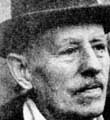 |
Brigadier General Reinhard Gehlen Chief, of the Third Reich's "Foreign Armies East." |
1944-1954
Germany/USA: Original Sin - From SS to OSS
By Martin A. Lee
The CIA's "original sin," dates back to when it used a Nazi spy network brimming with war criminals. The CIA protected this cast of killers to ostensibly counter the Soviet threat. The key player on the German side of this unholy alliance was Reinhard Gehlen, Hitler's top anti-Soviet spy. Gehlen oversaw Germany's military-intelligence capabilities throughout Eastern Europe and the U.S.S.R.
As the war drew to a close, the crafty Gehlen surmised that the grand anti-fascist coalition - led by the U.S., Britain and the Soviet Union - would not survive the peace. Gehlen also recognized that U.S. intelligence operations would be ill-prepared to wage a sustained struggle against the U.S.S.R.
Gehlen surrendered to a U.S. Counter-intelligence Corps team on May 22, 1945. He offered to share the vast espionage archive on the U.S.S.R. He also offered to activate an underground army of battle-hardened anti-communists in Eastern Europe.
Although the ink had barely dried on the Yalta agreements, which required the U.S. to give the Soviets any captured German officers who had been involved in "eastern area activities," Gehlen was transferred to Fort Hunt, Virginia.
During his 10 months at Fort Hunt, Gehlen presented a professional image, the pure technician who liked nothing better than to immerse himself in maps, flowcharts and statistics. Allen Dulles, head of the U.S. Office of Strategic Services (OSS) and future CIA director, became one of Gehlen's biggest post-war boosters.
With a mandate to continue gathering information in Eastern Europe just as he had been doing for Hitler, Gehlen re-established his spy organization, initially under U.S. Army supervision. The Gehlen "Org," as it was called, enlisted thousands of Gestapo, Wehrmacht and SS veterans.
Senior bureaucrats who administered the Holocaust were welcomed into the Org. (Alois Brunner, Adolf Eichmann's right-hand man and personal favorite, found gainful employment courtesy of Gehlen and the CIA.) "It seems," the Frankfurter Rundschau editorialized, "that in the Gehlen headquarters one SS man paved the way for the next and Himmler's elite were having happy reunion ceremonies."
U.S. officials knew that many of the people they were subsidizing had committed horrible crimes against humanity, but atrocities were overlooked as the anti-communist crusade gained momentum. Through Gehlen, the CIA had access to former leaders of virtually every Nazi puppet regime from the Baltics to the Black Sea, as well as a rogues gallery of Waffen SS fanatics.
Working within the CIA in the late 1940s, Gehlen's Nazi-infested spy apparatus functioned as America's secret eyes and ears in Central Europe. Under CIA auspices, and later as head of the West German secret service (BND), Gehlen influenced U.S. policy toward the Soviet Bloc. The Org played a major role within NATO, too, supplying two-thirds of raw intelligence on Warsaw Pact countries.
"We had an agreement to exploit each other, each in his own national interest," said James Critchfield, a CIA operative who worked with Gehlen on a daily basis for eight years. "The CIA loved Gehlen because he fed us what we wanted to hear," an ex-CIA officer told writer Christopher Simpson. "We used his stuff constantly and we fed it to the Pentagon, the White House and the newspapers. They loved it, too. But it was hyped up Russian bogeyman junk and it did a lot of damage to this country."
Washington's growing dependence on Gehlen made U.S. officials sitting ducks for disinformation. Much of what he supplied exaggerated the Soviet threat and whipped up fears about Russian military intentions. The Nazi spymaster fostered paranoia in the West about a worldwide communist conspiracy. Gehlen's strategy was based on a rudimentary equation; the colder the Cold War got, the more political space for Hitler's heirs.
While Gehlen catered to the CIA's anti-communist cravings, his Org became the life raft for legions of Hitler's SS henchmen to escape their crimes and resettle safely in the post-war world. Third Reich expatriates and fascist collaborators found jobs as "security advisers" in the Middle East and Latin America, where "death squads" persist as an enduring legacy.
The Gehlen debacle continues to exact a price against human decency in the world. It is a price rarely acknowledged amid Washington's post-Cold War triumphalism. After 50 years, the resurgence of fascism in Europe and elsewhere underscores the need for Americans to confront - and understand - some of these terrible demons of the Cold War past.
Gehlen worked with many secret fascist organizations, including:
Stepan Bandera's "B Faction," Organization of Ukrainian Nationalists
Romania's Iron Guard
the Ustachis of Yugoslavia
the Vanagis of Latvia
Vlassov's Army" in Russia.
Source: Christopher Simpson. Blowback:
America's Recruitment of Nazis and its Effects on the Cold War, 1988.
 |
West Germany's Spymaster
(1956-1968) |
In 1956, control of the Gehlen Org shifted from the CIA to West Germany's Intelligence Service. Gehlen was its director until he retired in 1968.
Soruce: "Gehlen Organization:, Nov 26, 1997. Federation of American Scientists: http://www.fas.org/irp/world/germany/intro/
Sources: members.nbci.com/1spy; www.cnn.com/SPECIALS/cold.war/kbank/profiles/allen.dulles/ , baltech.org/lederman/spray , www.newscoast.com/headlinesstory2.cfm?ID=35115
The Gehlen Org initially included Gehlen's immediate staff of about 350 agents. Hundreds of German army and SS officers were released from internment camps to join his headquarters in Germany's Spessart Mountains.
When the staff grew to 3,000, the Org moved to a compound near Pullach, south of Munich. It operated under the innocent name, South German Industrial Development Organization. By the early-1950s, the organization employed up to 4,000 intelligence specialists in Germany (mainly former army and SS officers) and more than 4,000 undercover agents who were active throughout the Soviet-bloc.
Under Operation Sunrise, some 5,000 anti-communist East Europeans and Russians were trained in Germany in 1946, under the command of General Sikes and SS General Burckhardt. They supported insurgencies in areas such as Ukraine, which were not suppressed by the Soviets until 1956.